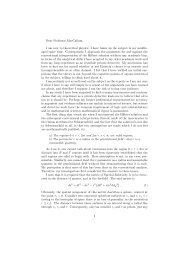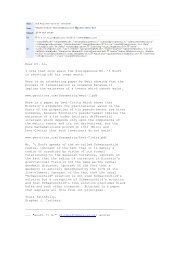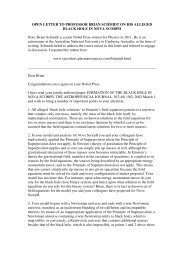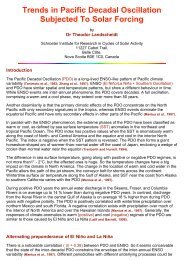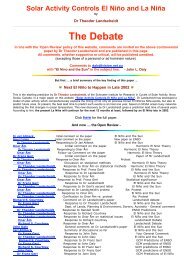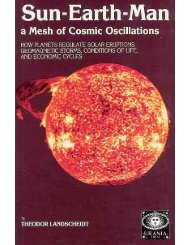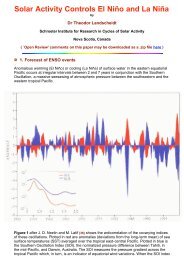THEODOR LANDSCHEIDT - The Golden Section - PlasmaResources
THEODOR LANDSCHEIDT - The Golden Section - PlasmaResources
THEODOR LANDSCHEIDT - The Golden Section - PlasmaResources
Create successful ePaper yourself
Turn your PDF publications into a flip-book with our unique Google optimized e-Paper software.
FIGURE 12. Wheeler's index of international battles. Big finger starts (triangles) alternately point to minima and<br />
maxima in the data. <strong>The</strong> minor (circles) and major (stars) golden-section points within the big fingers also alternate.<br />
<strong>The</strong> next maximum should develop around the minor in 2021, with a lull about 2007. After Mogey (1991).<br />
Forecasting is easy. <strong>The</strong> next minimum is expected about 2007, and the next peak about 2021. Consequently, the<br />
observation of golden-section points within cycles seems to be essential. <strong>The</strong> sun itself reveals which structural<br />
elements are important. <strong>The</strong> sun's dynamical fingers point to the number five, a close relative of the golden section.<br />
<strong>The</strong> number five, represented by a pentagon, is closely connected with the golden section. When all corners of the<br />
pentagon are connected by diagonals (FIGURE 13), a five-pointed star emerges. <strong>The</strong> intersecting lines of this<br />
pentagram form a web of golden sections. Within this star emerges a smaller pentagon that contains a smaller star<br />
with golden section divisions, and so on, in an infinite fractal sequence. Literature that delves into this connection is<br />
widespread (Kappraff 1991; Huntley 1970).<br />
Another close relative of the number five is the logarithmic spiral. FlG-URE 14 shows a golden rectangle, ADCB, that<br />
can be constructed easily from the square AFEB. Its proportions follow the golden section. <strong>The</strong> construction of smaller<br />
and smaller golden rectangles within golden rectangles produces a whirling fractal that gives birth to a golden spiral.<br />
This logarithmic spiral is the prototype of self-similarity, a fundamental fractal that resembles itself on any scale.<br />
Bernoulli, the Swiss mathematician who studied the spiral's properties, had it chiseled into his tombstone with the<br />
inscription, Eadem mutatus resurgo ("Transformed and yet the same, I shall rise from the dead"). This archetype is<br />
found in the spiral arms of huge galaxies and in the shapes of tiny creatures. A radiograph of the shell of the<br />
chambered Nautilus, a beautiful modern sea shell, shows this phenomenon (pictured on the magazine cover). <strong>The</strong><br />
size of the chambers, in which the Nautilus pompilius lives, increases with growth, but their shapes, based on the<br />
logarithmic spiral, remain proportionately unaltered.<br />
FIGURE 13. When all corners of a pentagon are connected by diagonals, a five-pointed star emerges. Its intersecting<br />
lines form a web of golden sections. Within this star is a smaller pentagon, containing a smaller star. Subdivision can<br />
be repeated to infinity.<br />
<strong>The</strong> golden spiral is intimately connected with cycles. Simple cyclic mathematical operations involving feedback, now<br />
studied in the new science of chaos, give birth to a wealth of fractal forms never seen before. FIGURE 15 shows the<br />
famous Mandelbrot set (panel a), a one-page dictionary of an infinity of individual patterns, called Julia sets, that all<br />
look different. Some scientists relate the Mandelbrot set to the genetic code found in the nuclei of cells. Consecutive<br />
amplifica-Ilifl §f fteyfltefy isetlens fllscloie at-tfsetlve patterns of artistic complexity (pantli 6, e, and d), what do we<br />
find? Logarithmic spirals!<br />
None of the professional "chaos" researchers seems to recognize that this finding suggests a close connection<br />
between cycles, the number five, the golden section, and the logarithmic spiral. To understand cycles in depth, these



